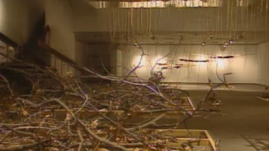Teachers' Domain - Digital Media for the Classroom and Professional Development
User: Preview



In this video segment, contemporary Native American artist Truman Lowe discusses his visit to an ancient Native American community in Western Kentucky, Wickliffe Mounds, and how it influenced his work. The segment also includes a tour of art works at the Eagle Gallery at Murray State University.
This resource is part of the Native American Culture collection.
Find additional arts resources for your classroom at the KET Arts Toolkit website.
From about 1000 to 1300, people of a now-vanished Native American society—the Mississippian culture—lived in a small town on the bluffs of the Mississippi River, at the far western end of what is now Kentucky. Today, at a site in Ballard County that we call Wickliffe Mounds, archaeologists continue to study this early Kentucky culture. In the spring of 1996, Truman Lowe, a nationally acclaimed Native American sculptor, worked with local students and Murray State University staff members to create an environmental sculpture at Wickliffe Mounds.
The prehistoric mounds of the Ohio and Mississippi valleys have fascinated people ever since their rediscovery. Two basic types of mounds have been identified: burial mounds, usually conical in shape, and temple mounds, generally larger and flat-topped. They are the hallmarks of several prehistoric groups, ancestors of modern American Indians. The most recent group, the Mississippians, arose about 800 and spread throughout the eastern United States along the great rivers and wherever there was rich, fertile soil. They developed as an agrarian society, and the mounds are their legacy. By 1500, the great mound centers were deserted (for reasons yet to be explained), although European explorers did meet people who appeared to have descended from the Mississippians, including the Choctaw, the Chickasaw, and the Tunica.
The Wickliffe Mounds Research Center is located in far Western Kentucky close to the confluence of the Ohio and Mississippi rivers. Approximately 900 years ago, this site was a moderately sized Mississippian Indian village. These mounds were created during the 300 years the village was occupied. During this period, homes burned down, material was lost or thrown out, and the ground slowly built up. Excavations have removed most of these “accumulation” mounds, revealing artifacts and features from the earlier periods of occupation. Visitors to the site can see pottery for storage and cooking, grinding stones, post hole patterns, and animal remains as well as home and burial sites. Wickliffe Mounds also features platform mounds, which formed the foundation of important public and ceremonial buildings.
The Wickliffe Mounds have been at the center of a controversial and painful issue in Kentucky’s history—that of one person’s archaeology being another’s grave desecration. During the winter and spring of 1996, the mounds served as an inspiration for contemporary Native American artist Truman Lowe, who created four works of art in response to what he saw and felt upon visiting this ancient Indian settlement on the bluffs overlooking the Mississippi River. He returned to create another work on-site with the help of students from several Western Kentucky counties.
The Wickliffe Mounds Research Center is open to school tours and offers a variety of teacher’s guides and information about Native peoples, the Mississippian culture, mounds, and archaeology. Visitors may also see the sculpture created by Lowe and his students, made from materials found on the site and standing as a testament to the enduring legacy of the people who made this site their home. In 2004, the Kentucky Department of Parks acquired Wickliffe Mounds from Murray State University as a state historic site.
 Loading Standards
Loading Standards